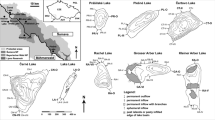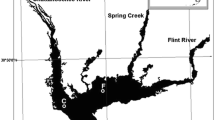Abstract
Limnological data were collected over a two-year period from 12 lakes in the Missouri River floodplain in order to evaluate lake trophic status and the influence of basin type and connectivity on nutrient, seston, and phytoplankton dynamics. The lakes were located in west-central Missouri and included eight scour basins formed by levee breaks during a 1993 flood and four older oxbow lakes. The Missouri River was also sampled. Five of the scour basins (connected scours) were inundated by the Missouri River for varying periods during the study. The other lakes (protected lakes) were hydrologically isolated from the river by levees. On the basis of mean total phosphorus (TP-61-282 μg/L), mean total nitrogen (TN-0.7-2.1 mg/L), mean chlorophyll (CHL-22-67 μg/L), and mean suspended solids (TSS-16-93 mg/L), all 12 sites were highly eutrophic compared to other lakes in Missouri. Nutrient fractions and seston composition indicated dominance of inorganic nutrients and abiotic seston in the riverine lakes. Maximum concentrations of nutrients and TSS occurred in oxbow lakes during periods of sediment resuspension and in connected scours during floods in spring 1995 and 1996 when connected sites were inundated by the Missouri River. Algal blooms with peak CHL>200 μg/L occurred sporadically in the oxbow lakes. Similarly large blooms (peak CHL 81–689 μg/L) occurred in connected scours when low river levels reduced exchange with the river. Reduced connectivity was accompanied by rapid loss of dissolved N and P fractions, especially nitrate. Protected scours had lower average TP, TN, and TSS than the other sites and were less temporally variable.
Similar content being viewed by others
Literature Cited
American Public Health Association 1985. Standard methods for the examination of water and wastewater, 16th Edition. American Public Health Association, New York, NY, USA.
Amoros, C. 1991. Changes in side-arm connectivity and implications for river system management. Rivers 2:105–112.
Carper, G. L. and R. W. Bachmann. 1984. Wind resaspension of sediments in a prairie lake. Canadian Journal of Fisheries and Aquatic Sciences 41:1763–1767.
Crumpton, W. G., T. M. Isenhart and P. D. Mitchell. 1992. Nitrate and organic N analyses with second-derivative spectroscopy. Limnology and Oceanography 37:907–913.
Galat, D. L., J. F. Kubisiak, J. B. Hooker, and L. M. Sowa. 1996. Geomorphology, distribution and connectivity of Lower Missoari River floodplain waterbodies scoured by the flood of 1993. Proceedings—International Association of Theoretical and Applied Limnology 26.
Hamilton, S. K. and W. M. Lewis, Jr. 1990. Basin morphology in relation to chemical and ecological characteristics of lakes on the Orinoco River floodplain, Venezuela. Archiv fur Hydrobiologie 119:393–426.
Hoyer, M. V. and J. R. Jones. 1983. Factors affecting the relation between phosphorus and chlorophyll a in midwestern reservoirs. Canadian Journal of Fisheries and Aquatic Sciences 40:192–199.
Jones, J. R. 1977. Chemical characteristics of some Missouri reservoirs. Transactions of the Missouri Academy of Science 11:58–71.
Jones, J. R. and M. F. Knowlton. 1993. Limnology of Missouri reservoirs: An analysis of regional patterns. Lake and Reservoir Management 8:17–30.
Junk, W. J., P. B. Bayley, and R. E. Sparks. 1989. The flood pulse concept in river-floodplain systems. Canadian Special Publication of Fisheries and Aquatic Sciences 106:110–127.
Knowlton, M. F. 1984. Flow-through microcuvette for fluorometric determination of chlorophyll. Water Resources Bulletin 20:795–799.
Knowlton, M. F. and J. R. Jones. 1995. Temporal and spatial dynamies of suspended sediment, nutrients, and algal biomass in Mark Twain Lake, Missouri. Archiv fur Hydrobiologie 135:145–178.
Knowlton, M. F. and J. R. Jones. 1996. Experimental evidence of light and nutrient limitation of algal growth in a turbid midwest reservoir. Archiv fur Hydrobiologie 135:321–335.
Osgood, R. A. 1988. Lake mixis and internal phosphorus loading. Archiv fur Hydrobiologie 113:629–638.
Prepas, E. E. and F. A. Rigler. 1982. Improvements in quantifying the phosphorus concentration in lake water. Canadian Journal of Fisheries and Aquatic Sciences 39:822–829.
Reynolds, C. S. 1984. The ecology of freshwater phytoplankton. Cambridge University Press, Cambridge, UK.
Sartory, D. P. and J. U. Grobbelaar. 1984. Extraction of chlorophyll a from freshwater phytoplankton for spectrophotometric analysis. Hydrobiologia 114:177–187.
Scheffer, M., S. H. Hosper, M. L. Meijer B. Moss, and E. Jeppesen. 1993. Alternative equilibria in shallow lakes. Trends in Evolution and Ecology 8:275–279.
Søballe, D. M. and B. L. Kimmel. 1987. A large scale comparison of factors influencing phytoplankton abundance in rivers, lakes and impoundments. Ecology 68:1943–1954.
Søballe, D. M. and S. T. Threlkeld. 1985. Advection, phytoplankton biomass, and nutrient transformations in a rapidly flushed impoundment. Archiv fur Hydrobiologie 105:187–203.
Stainton, M. P., M. S. Capel, and F. A. J. Armstrong. 1977. The Chemical Analysis of Freshwater, 2nd edition. Fisheries Marine Service Miscellaneous Special Publication. No. 25. Fisheries and Environment Canada. Winnipeg, Manitoba, Canada.
Thom, R. H. and J. F. Wilson. 1980. The natural divisions of Missouri. Transactions of the Missouri Academy of Science 14:9–23.
Van Nieuwenhuyse, E. E. and J. R. Jones. 1996. Phosphorus-chlorophyll relationships in temperate streams and its variation with stream catchment area. Canadian Journal of Fisheries and Aquatic Sciences 53:99–105.
Ward, J. V. and J. A. Stanford. 1995. Ecological connectivity in alluvial river ecosystems and its disruption by flow regulation. Regulated Rivers: Research & Management 11:105–119.
Author information
Authors and Affiliations
Rights and permissions
About this article
Cite this article
Knowlton, M.F., Jones, J.R. Trophic status of Missouri River floodplanin lakes in relation to basin type and connectivity. Wetlands 17, 468–475 (1997). https://doi.org/10.1007/BF03161512
Received:
Revised:
Accepted:
Issue Date:
DOI: https://doi.org/10.1007/BF03161512




